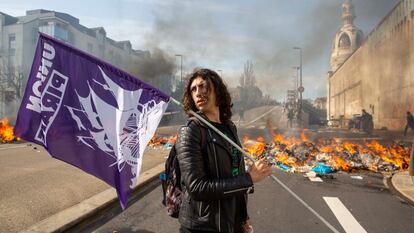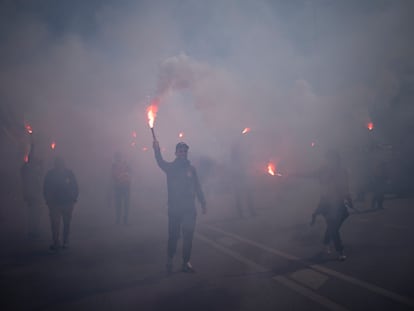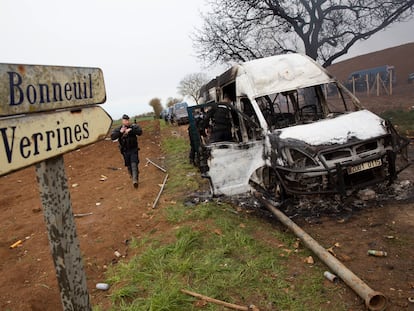French youths take on Macron: ‘We feel that there is an urgency to fix things, that there is no time to negotiate’
EL PAÍS spoke to students at a protest in Nantes about why they are joining the demonstrations against the government’s pension reform plan

Sacha Coatantiec, 21, is carrying the purple flag of his student union, Pirate Action. He’s got curly hair and is dressed in a black T-shirt and leather jacket. It is Tuesday, and this geography student at the University of Nantes is heading, along with other union members, a demonstration in the French city of Nantes. Sacha is the leader and founder of Pirate Action, which has 80 members. Students have joined the protests against the French government’s plan to raise the retirement age, and now, after nearly 30 demonstrations, there is almost no one who has not taken part.
Standing next to Sacha is Dragan Auverty, a journalism student. He is carrying a camera to take photos and has a helmet in case things with the police get ugly (which they will later). He cleans his glasses. He checks that he has eye drops to calm the sting of tear gas. He criticizes French President Emmanuel Macron for passing the retirement bill by decree — instead of putting it to a vote — a move he calls undemocratic. And he talks about his growing distrust in institutions and dealing with an uncertain future. “What we young people feel is that everything is speeding up, that crises are speeding up. I have already lived through many. Too many: 2008 [financial crisis], the pandemic, war [in Ukraine], inflation, the general crisis of the planet. There is a feeling among us of urgency, that things have to be fixed quickly, that there is no time to negotiate.”
The protest starts. It’s 12:00. According to the unions, there are 60,000 people. According to the authorities, there are fewer than 18,000. A smaller number, in any case, than the 40,000 who marched on March 23. News arrives that the numbers at the Paris protest are also lower compared to last week.
Passing by prefecture headquarters, several youths in hoodies and black clothes — the so-called black blocs from the far left — group together in a turtle-shape formation, protecting each other with umbrellas. Hidden from sight, they graffiti the walls of the headquarters: “Sainte-Soline: the day of revenge has arrived.” The message refers to the violent confrontation between police and environmentalists that took place on Saturday near the town of Sainte-Soline. There were serious injuries on both sides, and one of the protesters is still battling for life. It’s yet another example of the destructive shift that France is seeing.
Sacha talks about youth precariousness, unemployment, what awaits him when he finishes his degree. Later, he joins in on a chant about the union between students and workers. Then comes the global chant against Macron. The French president is the target for all the protesters’ anger: he is the one who is blamed and reproached. At the march, cartoons, chants and dozens of banners mention him. One banner simply says: “Manu, chau” — a play on words that references French-Spanish singer Manu Chao. An old phrase by Victor Hugo has also come back to the fore and is seen on many banners: “Yesterday, you were a swarm. Today, you are a people.” It’s an allusion to a comment by Macron, who stated that the masses had no right to take the street.
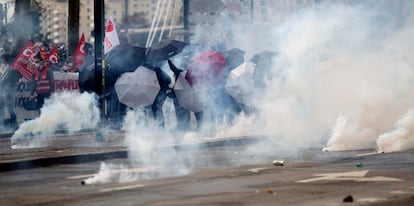
There are families at the protest, but few children because everyone knows that it’s going to get violent at some point. There are thousands of trade unionists, wearing the orange and red vest of the CGT union. And there are also thousands of students, many dressed in the blue smocks of student doctors and nurses. The black blocs slip along the sides, through alleys that run parallel to the main avenue, where the bulk of the march is. One of them is collecting stones along the way. Another one turns over trash containers and sets them up as barricades. A third has climbed a pole and, amid thunderous applause, knocks over a camera recording the demonstration.
Tituan Guihd, 21, a history student, also from the Pirate Action student union, defends the black blocs: “They don’t break things just to break things. They only go after capitalist symbols, like a bank office or billboards. There’s an ideology behind what they do. They are not just barbarians. And if a trash container is set on fire, well, it’s not a big deal either. The violence from the other side, from the police, is worse, and it feeds the other side.”
Riot police line up on both sides. There is more and more of them. They wear dark helmets, batons, blue body armor and clear plastic shields. They gather in packs and quickly rush forward.
Next to a van with a PA system, a young man yells that rights were never won by law. “From the French Revolution to the vote for women, everything was won on the streets, this is where those battles are won.” Sacha applauds. Titouan, too. Next to them, two black-clad protesters push a container filled with empty bottles to a corner.
At 2:00 p.m., the street has become a battlefield. The most violent demonstrators challenge the police by throwing stones, empty bottles and small projectiles at them. The riot police respond with batons and tear gas. On the sidewalk, six protesters carry a wounded man with a bandaged head: his face covered in blood and his eyes have a distant look. There is a haze of white as the acidic smell of tear gas rises.
Many protesters take refuge in bars, shops or doorways from where they silently watch the fighting, recording everything with their cellphones. When one of them is asked why every demonstration in France ends in chaos, they reply smiling: “It’s part of our culture, like the baguette.”
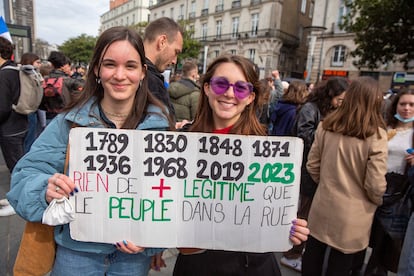
There are more young people surrounding Sacha’s group, located far from the fighting, a little to the rear. Adèle Gratadon, a literature student, knows perfectly well why she is there: “I am fighting because the government doesn’t respect the people who demonstrate, because the government doesn’t listen. And also because, although my retirement is far off, we must fight for that of others, for that of the older generations. This is not about my retirement, or anyone else’s. It is about society in general, about everything.”
In the afternoon, the city has descended into guerrilla warfare madness. Dozens of hooded youths come to a corner, and in the middle of the road, pile up trash — which has been building up due to the strikes over the pension plan — shopping carts from a nearby supermarket and pallets found from who knows where. They set fire to the mountain of metal and waste that burns like a pyre, reaching almost a story high.
Meanwhile, in the background, next to one of the fires, Sacha and his gang of friends walk by — none of them are covering their faces, or carrying stones or Molotov cocktails. The group instead is waving, as high as they can, the little purple flag for Pirate Action.
Sign up for our weekly newsletter to get more English-language news coverage from EL PAÍS USA Edition
Tu suscripción se está usando en otro dispositivo
¿Quieres añadir otro usuario a tu suscripción?
Si continúas leyendo en este dispositivo, no se podrá leer en el otro.
FlechaTu suscripción se está usando en otro dispositivo y solo puedes acceder a EL PAÍS desde un dispositivo a la vez.
Si quieres compartir tu cuenta, cambia tu suscripción a la modalidad Premium, así podrás añadir otro usuario. Cada uno accederá con su propia cuenta de email, lo que os permitirá personalizar vuestra experiencia en EL PAÍS.
¿Tienes una suscripción de empresa? Accede aquí para contratar más cuentas.
En el caso de no saber quién está usando tu cuenta, te recomendamos cambiar tu contraseña aquí.
Si decides continuar compartiendo tu cuenta, este mensaje se mostrará en tu dispositivo y en el de la otra persona que está usando tu cuenta de forma indefinida, afectando a tu experiencia de lectura. Puedes consultar aquí los términos y condiciones de la suscripción digital.
More information
Últimas noticias
Rowan Atkinson tops Netflix at 70: ‘He’s as funny as ever’
Israeli recognition of Somaliland stirs up the Gulf
Tiger Woods turns 50: Will he continue playing on the PGA Tour or take a back seat?
The surreal journey of James Nnaji, the Barcelona youth player selected in the NBA Draft who ended up in the NCAA
Most viewed
- Oona Chaplin: ‘I told James Cameron that I was living in a treehouse and starting a permaculture project with a friend’
- Reinhard Genzel, Nobel laureate in physics: ‘One-minute videos will never give you the truth’
- Sinaloa Cartel war is taking its toll on Los Chapitos
- Why the price of coffee has skyrocketed: from Brazilian plantations to specialty coffee houses
- Chevy Chase, the beloved comedian who was a monster off camera: ‘Not everyone hated him, just the people who’ve worked with him’
